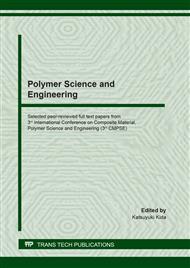p.129
p.140
p.146
p.151
p.157
p.165
p.174
p.182
p.188
Strength, Durability and Degradation Properties of Bioplates Produced from Durian Seed Mixed with Poly(Lactic Acid)
Abstract:
In this study, durian seed was used to mix with poly (lactic acid), PLA for bioplates production. Durian seeds were prepared to peel off the brown skin on durian seed and then were dried. It was called brown skin durian (BSD). BSD was reduced the size below 1 mm. The mixtures between BSD and PLA were varied at 10:90, 20:80, 30:70 g/g. All mixtures were compressed into bioplates mold with varying the temperature at 90, 110, and 130 °C and the pressure at 2.0, 2.7, and 3.4 MN/m2. Bioplates sample were also investigated the properties in term of water absorption, tensile strength, and degradation. Results showed that the optimal mixture between BSD and PLA was 30:70 g/g and the suitable production condition presented the temperature and pressure at 130 °C and 3.4 MN/m2, respectively. These conditions provided low water absorption, high tensile strength and provided the proper degradation within 7 days. Hence, agricultural waste (durian seed) can be combined with PLA to produce the bio-container as bioplates which presented the potential to use in waste management.
Info:
Periodical:
Pages:
157-162
Citation:
Online since:
August 2020
Authors:
Keywords:
Price:
Сopyright:
© 2020 Trans Tech Publications Ltd. All Rights Reserved
Share:
Citation:


